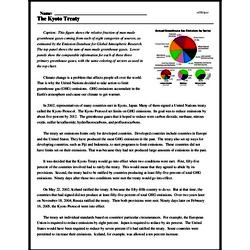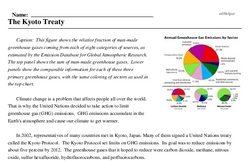The Kyoto Treaty
Caption: This figure shows the relative fraction of man-made greenhouse gases coming from each of eight categories of sources, as estimated by the Emission Database for Global Atmospheric Research. The top panel shows the sum of man-made greenhouse gases. Lower panels show the comparable information for each of these three primary greenhouse gases, with the same coloring of sectors as used in the top chart.
Climate change is a problem that affects people all over the world. That is why the United Nations decided to take action to limit greenhouse gas (GHG) emissions. GHG emissions accumulate in the Earth's atmosphere and cause our climate to get warmer.
In 2002, representatives of many countries met in Kyoto, Japan. Many of them signed a United Nations treaty called the Kyoto Protocol. The Kyoto Protocol set limits on GHG emissions. Its goal was to reduce emissions by about five percent by 2012. The greenhouse gases that it hoped to reduce were carbon dioxide, methane, nitrous oxide, sulfur hexafluoride, hydrofluorocarbons, and perfluorocarbons.
The treaty set emissions limits only for developed countries. Developed countries include countries in Europe and the United States. They have produced the most GHG emissions in the past. The treaty also set up ways for developing countries, such as Fiji and Indonesia, to start programs to limit emissions. These countries did not have limits set on their emissions. That was because they had not produced large amounts of emissions in the past.
It was decided that the Kyoto Treaty would go into effect when two conditions were met. First, fifty-five percent of the countries involved had to ratify the treaty. This would mean that they agreed to abide by its provisions. Second, the treaty had to be ratified by countries producing at least fifty-five percent of total GHG emissions. Ninety days after those two conditions were met the treaty would go into effect.




